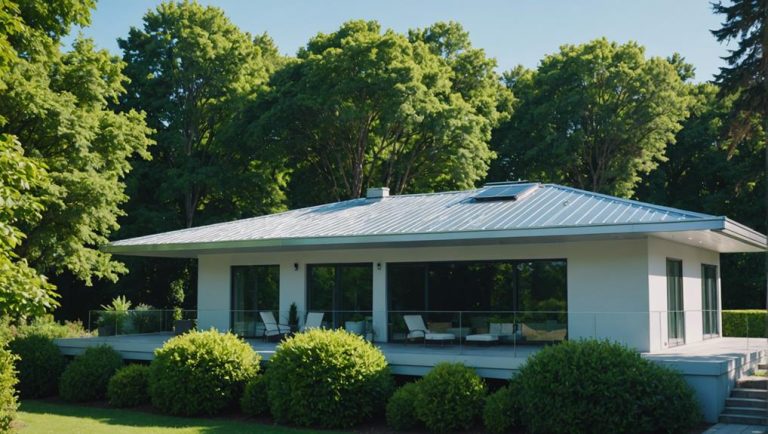To master commercial roof maintenance basics, prioritize regular inspections. Twice-yearly checks, especially after severe weather, are crucial. Trained contractors aid in early issue detection to prevent escalation. Create a RAM plan for timely maintenance, tracking warranties, and repairs for effective management. Embrace preventative maintenance to extend roof lifespan and save costs. Budget accurately for repairs and replacements with proactive maintenance practices. Utilize self-inspection checklists meticulously to assess for damage and ensure safety. These fundamentals set the foundation for optimal roof performance and durability.
Key Takeaways
- Conduct regular inspections to safeguard structural integrity and longevity.
- Implement a RAM plan for timely maintenance schedules and budgeting.
- Embrace preventative maintenance to optimize roof performance.
- Budget for repairs and replacements to prevent disruptions.
- Use a self-inspection checklist to assess roofing components thoroughly.
Importance of Regular Inspections
Conducting regular inspections on commercial roofs is a fundamental practice essential for safeguarding the structural integrity and longevity of the building and protecting its valuable assets. Recommended inspection frequency typically involves scheduling inspections twice a year, ideally in spring and fall, to catch any issues early.
However, immediate inspections are crucial after severe weather events such as high winds or heavy precipitation. Trained Portland roofing contractors play a pivotal role in these inspections, as their expertise is instrumental in the early detection of any potential problems.
Early detection during inspections can prevent minor issues from escalating into significant concerns, ultimately saving time and money in the long run.
Implementing a RAM Plan
Implementing a Roof Asset Management (RAM) plan is vital for comprehensive commercial roof maintenance and effective management of roofing assets. When creating a RAM plan, consider these key points:
- Creating Maintenance Schedules: Establishing regular maintenance schedules ensures timely inspections and upkeep.
- Tracking Warranties: Keep track of roofing materials and workmanship warranties to leverage coverage when needed.
- Documenting Repairs: Record all repairs and maintenance activities to track the roof’s history and performance.
- Setting Budgets: Utilize RAM plans to set accurate budgets for repairs and replacements based on maintenance needs and warranties.
Embracing Preventative Maintenance
To ensure the longevity and optimal performance of commercial roofs, embracing preventative maintenance practices is paramount in safeguarding the structural integrity and functionality of the building. Taking a proactive approach by conducting regular inspections, creating a Roof Asset Management (RAM) plan, and addressing minor issues promptly can significantly extend the roof’s lifespan.
By being proactive rather than reactive in maintenance, property owners can prevent disruptions to operations and save on long-term costs. Embracing preventative maintenance not only helps identify and fix issues early, such as ponding and gutter clogs but also contributes to long-term savings by avoiding more significant problems that may arise in the future.
Prioritizing preventative maintenance strategies is critical to ensuring the commercial roof’s durability and performance over time.
Budgeting for Repairs and Replacements
Prioritizing budget allocation for necessary repairs and replacements is essential to manage commercial roof maintenance effectively. To ensure cost-effective strategies and efficient financial planning, consider the following:
- Implement Regular Inspections: Scheduled inspections help in the early detection of issues, allowing for timely repairs and replacements.
- Utilize Roof Asset Management (RAM) Plans: Documenting roof details aids in setting accurate budgets and organizing preventative maintenance strategies.
- Plan for Downtime: Allocating time for repairs prevents disruptions to operations and ensures proper maintenance.
- Avoid Procrastination: Addressing repairs promptly can prevent minor issues from escalating into costly problems.
Self-Inspection Checklist Essentials
When conducting a self-inspection of your commercial roof, it is crucial to meticulously assess all roofing system components for any signs of damage or deterioration. Start by conducting a thorough assessment of the roofing material to check for wear and tear.
Ensure proper safety measures are in place before beginning the inspection. Evaluate the drainage system to confirm it is functioning correctly and preventing water ponding.
Additionally, inspect all sealants for any cracks or gaps that may lead to leaks. By following these steps and incorporating a detailed checklist, property owners can effectively identify and address potential roofing issues early on, ensuring the longevity and performance of their commercial roof.
Frequently Asked Questions
Can Commercial Roof Maintenance Be Postponed or Skipped if the Building Is Not in Use for an Extended Period?
Maintenance scheduling is critical regardless of building occupancy status. Neglecting Portland commercial roof maintenance, even during vacancy, can lead to severe long-term consequences such as structural damage, leaks, and costly repairs. Regular upkeep is essential for preservation.
How Can Property Owners Differentiate Between Routine Maintenance Tasks That Can Be Handled Internally Versus Those That Require Professional Assistance?
To differentiate between routine maintenance tasks, property owners should focus on the complexity of the work, potential risks, and their level of expertise. DIY tasks like gutter cleaning can be handled internally, while issues like roof leaks require professional assistance for effective resolution.
Are There Any Specific Insurance Considerations when Creating a RAM Plan for Commercial Roof Management?
When creating a RAM plan for commercial roof management, insurance considerations for risk management are also important. Insurance coverage should align with the RAM plan to mitigate risks effectively. Adequate coverage ensures cost-saving measures and professional assistance when needed.
How Can Technology and Data Analytics Be Integrated Into Commercial Roof Maintenance Practices to Optimize Efficiency and Accuracy?
Integrating technology and data analytics into commercial roof maintenance practices optimizes efficiency and accuracy. Through advanced monitoring tools, predictive maintenance enhances early issue detection, prolonging roof lifespan. Data-driven insights streamline decision-making, reducing operational disruptions and costs.
What Common Misconceptions or Myths About Commercial Roof Maintenance Should Property Owners Be Aware Of?
Costly misconceptions in commercial roof maintenance include neglecting timely inspections and proper planning. Property owners should prioritize preventive measures to avoid significant repairs. Understanding the value of routine maintenance is critical to extending the roof’s lifespan.



